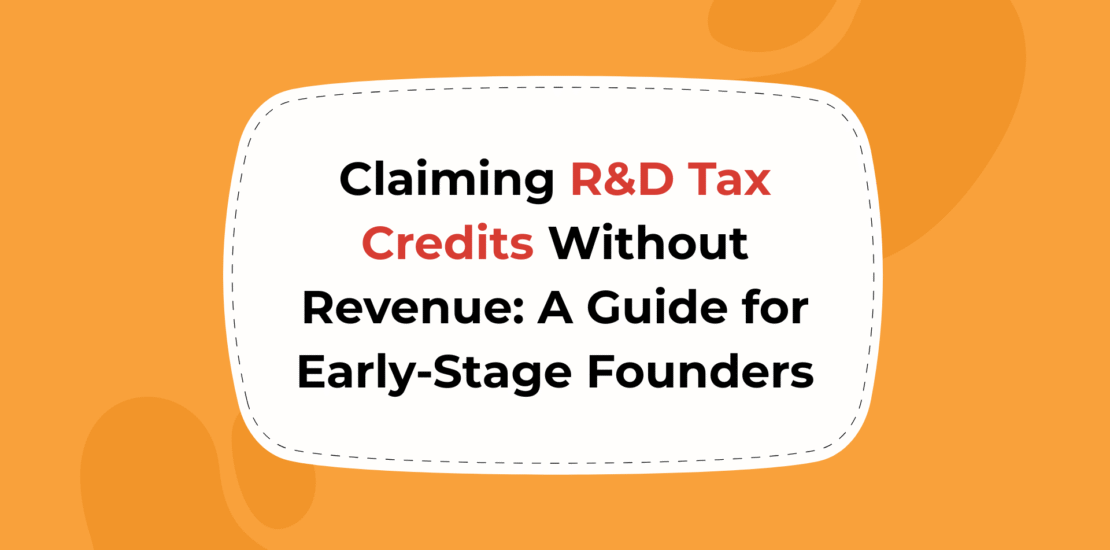How to Claim R&D Tax Credit with No Revenue as a Startup
- July 12, 2025
- Posted by: Noushed Shaikh
- Category: Uncategorized

If your business is building a product or investing in technical development but hasn’t generated income yet, you may still qualify for the R&D tax credit with no revenue. This powerful tax incentive allows early-stage startups to reduce their payroll tax liability, even before turning a profit.
In this guide, you’ll learn how early-stage businesses can benefit, what types of work qualify as R&D, and how to claim credits for previous years.
How the R&D Credit Applies Before Profitability
The R&D tax credit isn’t just for profitable businesses. Thanks to updates under the PATH Act, even early-stage companies with no income can still benefit through payroll tax savings.
No Profit Required
Your business doesn’t need to be profitable to qualify for the R&D payroll tax credit. As long as your team is performing eligible research and development work and paying wages to U.S.-based employees, you can benefit from this credit.
Offset Payroll Taxes Directly
Instead of waiting to become profitable to use the credit against income tax, early-stage companies can apply the R&D credit to reduce their employer portion of Social Security taxes up to $500,000 annually.
Focus on Technical Staff
To qualify, your company must employ technical team members working on qualifying R&D activities. Payroll costs tied to those employees can be used to claim the credit. Businesses with only contractors are not eligible to use the payroll tax offset.
How Early-Stage Businesses Can Benefit from the R&D Tax Credit

For early-stage businesses, every dollar matters, especially when you’re building products and not yet generating revenue. The R&D payroll tax credit helps reduce costs when cash flow is tight by offering relief on payroll taxes.
Instead of waiting to turn a profit, your company can access the credit as long as it’s:
- Spending on qualified technical work
- Paying U.S.-based employees
- Filing payroll taxes through Form 941
This means you can benefit during the development phase, not just after product launch.
Real Benefits for Pre-Revenue Teams:
Lower Burn Rate:
Reduce the actual payroll taxes you owe, keeping more money in the business.
Cash Flow Boost:
Reinvest savings into engineering, testing, or hiring new talent.
No Revenue Needed:
You don’t need to show profits or even sales to claim this credit, just R&D activity.
Example:
Let’s say your team paid $100,000 in salaries to developers building a new platform. You could receive a $10,000 to $15,000 reduction in payroll taxes even if you had zero revenue that year.
This credit is one of the few tools available that actively supports innovation from day one. If you’re investing in technical progress, it’s worth claiming the credit early.
How to Claim the Credit for Previous Years
If you missed claiming the R&D payroll tax credit in earlier years, you can still take advantage of it. The IRS allows you to amend returns from the past three tax years and apply the credit retroactively. This is especially valuable for early-stage businesses that were investing in R&D but didn’t generate revenue at the time.
Here’s how to do it properly:
1. Review Your Prior-Year Eligibility
Start by checking if your company met the eligibility criteria in the years you plan to amend. You must ensure:
- The company was less than five years into generating gross receipts.
- Gross receipts for the tax year were $5 million or less.
- Your business had U.S.-based employees and filed Form 941 (payroll tax return).
- You conducted qualifying R&D activities during those years.
2. Gather All Supporting Documentation
You need proper records to support your claim. For each year:
- Identify employees who worked on R&D activities.
- Collect payroll records, time-tracking sheets, and job descriptions.
- Maintain technical documentation showing the scope and nature of the R&D work.
- If contractors are involved, keep signed contracts, invoices, and deliverables.
These documents will help your CPA calculate the eligible credit and defend it in case of an audit.
3. Calculate the R&D Tax Credit
Work with a tax advisor or R&D credit specialist to determine the eligible expenses for each year. You will typically claim between 6% and 14% of those expenses, depending on your method of calculation.
4. File Tax returns
To claim the credit, you’ll need to file the following forms:.
- Form 6765: This form reports your R&D credit calculation.
- Form 8974: Use this to apply the credit to payroll taxes.
These forms needs to be filed along with Form 1120
While your CPA will handle the filings, it’s important to stay informed and review all submissions for accuracy
Example
Let’s say your company spent $120,000 on qualifying R&D work in 2022 but didn’t file for the credit. By amending your 2022 return, you could potentially claim $12,000 to $18,000 in payroll tax credits and apply that against earlier payroll tax liabilities or receive a refund.
Need Help Navigating the R&D Credit Without Revenue?
Schedule a free consultation now.
At LedgersCFO, we work closely with early-stage businesses to help them claim the R&D tax credit with no revenue. If your company is spending on technical development or product research, the credit may apply to you.
We assist with everything from identifying eligible activities to gathering proper documentation
Whether you’re applying for the first time or correcting a missed opportunity from a previous year, our team ensures the filing is accurate, timely, and fully compliant with IRS requirements.
FAQ’S
1. Can I claim the R&D tax credit if my company hasn’t earned any revenue?
Yes. As long as your business is conducting qualified research and paying U.S.-based employees, you can apply the credit to offset payroll taxes, even without revenue.
2. What kind of work qualifies as R&D for this credit?
Technical work like software development, building platforms, designing algorithms, prototyping, or improving a product’s functionality usually qualifies. Non-technical work like sales, HR, or admin does not.
3. Can I use the credit to reduce income tax later if I become profitable?
Yes. If your company becomes profitable in the future, you can apply unused R&D credits toward your income tax liability, depending on your credit balance.
4. How far back can I claim R&D credits if I missed them in previous years?
You can amend returns from the last three tax years to claim credits for eligible R&D expenses during that period.
5.How does LedgersCFO help with claiming the R&D tax credit?
LedgersCFO guides early-stage businesses through the full process from identifying qualifying work and collecting required documentation to coordinating with your CPA for accurate filing. We make sure the credit is claimed properly, even if your business has no revenue yet.

